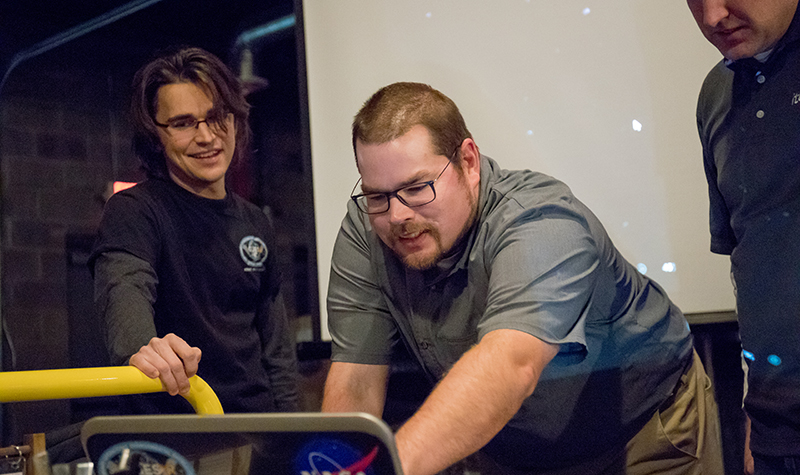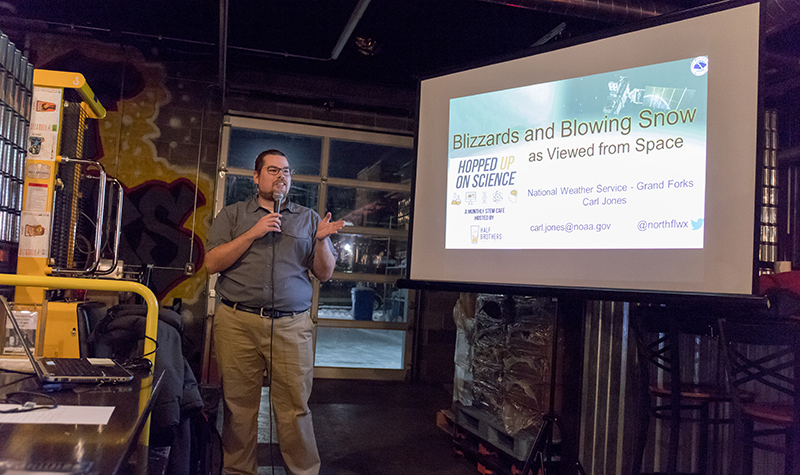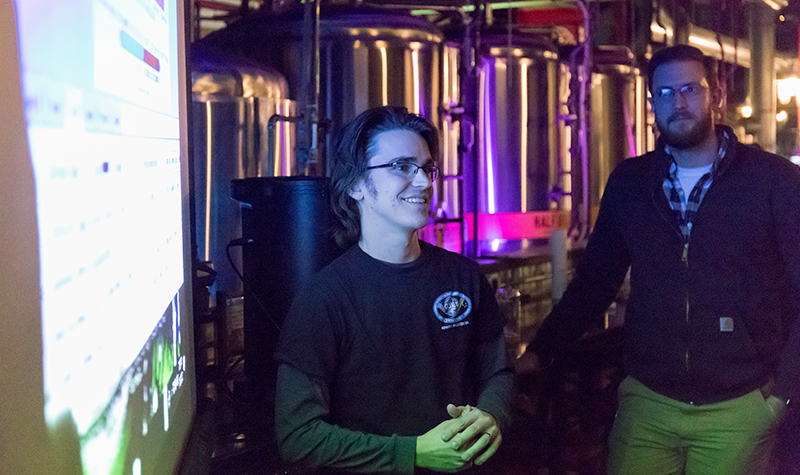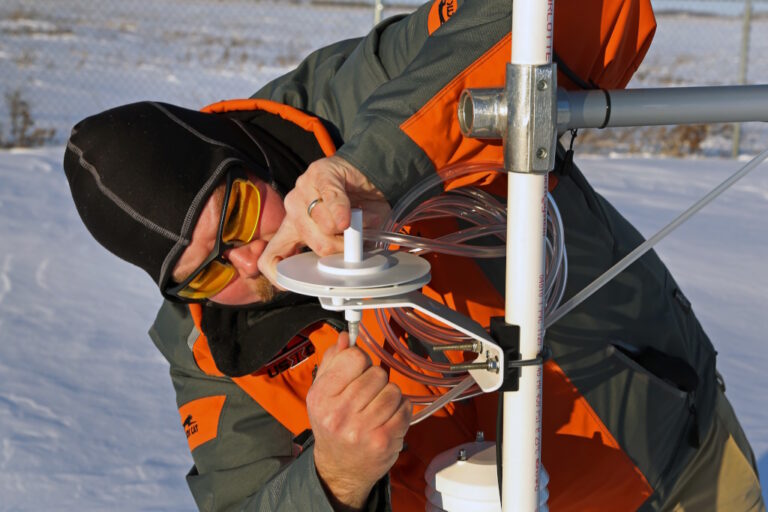STEM Café brings blizzard research to downtown craft brewery
Aaron Kennedy’s STEM Café idea takes root downtown, brings UND and local expertise to public square

Associate Professor Aaron Kennedy (center) and Carl Jones (left) presented the latest installment of “Hopped Up on Science,” which Kennedy has hosted monthly, during the academic year, since fall 2018. Photo by Connor Murphy/UND Today.
A couple years ago, after a fresh snowfall, a cold front came through the Red River Valley.
The front’s strong winds lifted the loose snow and blew it across the plains — a familiar phenomenon around the blizzard capital of the Lower 48.
At Grand Forks’ National Weather Service station, meanwhile, meteorologist Carl Jones jumped out of his chair and rushed to find his managers. He had made a discovery that no one quite expected.
And last week, the circumstances of Jones’ discovery were the topics of his latest lecture — not at a conference, not at an open house at the weather station, but at a local pub.
“Hopped Up on Science” is the STEM Café-styled brainchild of UND Associate Professor Aaron Kennedy in the Department of Atmospheric Sciences. Hosted in downtown Grand Forks at Half Brothers Brewery, the monthly STEM Café has been Kennedy’s means of telling the public about science, technology, engineering and math — among other topics — in a casual setting.
“A couple years ago, I had the thought, ‘It’s been a long time since there’s been something like a STEM Café in town,’” said Kennedy, who’s been at UND since becoming the first atmospheric sciences Ph.D. candidate in 2006. “I thought with the venues available that it was a perfect time to start one up.”
As a scientist, Kennedy enjoys showcasing the research he’s doing, but he also wants to call attention to other people’s work at UND. After starting out in fall 2018 with a tight circle of acquaintances, Kennedy has been able to reach across campus to bring the expertise of UND to the public square.

Kennedy strives for diverse topics at the STEM Café he started, but Wednesday evening’s presentation was related to some of his own and Carl Jones’ research. The two are soon to submit a paper regarding the newfound capabilities of the country’s latest and greatest weather satellites. Photo by Connor Murphy/UND Today.
Close to home
Last Wednesday’s installment of the STEM Café was close to home for Kennedy, because the topic was directly related to his own research.
Jones’ discovery in 2018 is the subject of a collaborative research paper that he and Kennedy hope to submit for publication. Jones’ talk at Half Brothers, which Kennedy hosted, focused on the technical capabilities of satellite-based meteorology, and the implications of the latest and greatest weather satellites.
“A couple of years ago, our country put up the latest weather satellite that observes weather data in real time,” Kennedy told UND Today. “It’s faster, higher resolution and it observes more wavelength bands than any satellite previous.”
The satellite to which Kennedy refers is the GOES-R: the Geostationary Operational Environmental Satellite R-Series. Previously, weather data would be obtained from polar-orbiting satellites, which would pass over a specific part of the globe once or twice a day. Now observers have a satellite locked in on the continental United States 24 hours a day.
“We started seeing data from these different wavelength bands that it senses,” Kennedy said. “We realized that we could now see blowing snow — blizzard events — from space in real time.”
That was the observation that brought Jones out of his chair in 2018. Soon afterward, Jones and Kennedy started working on a paper communicating this capability to the atmospheric science community.
“This new technology that we have up in space, that is all publicly available to view, has all sorts of applications,” Jones said. “It adds so much more detail in such a timely manner, which is critical in a fast-paced environment where we need to make forecasts and issue warnings to the public.”
But the advantages come with limitations, as Jones’ talk showed. Conditions have to be optimal to observe blowing snow, since the phenomenon happens just above ground level. For instance, if an observer is trying to look at blowing snow in the Grand Forks region, there cannot be existing cloud cover. Also, it has to be daytime. Visible light is necessary to highlight the ice particles in question.
And even if the conditions for space-based observation are near-perfect, it’s still hard to determine the range of visibility at the ground level.
For the National Weather Service, the geostationary satellite is a sensitive new eye for watching the weather. The agency now “sees” from platforms ranging from thousands of miles above the earth to cameras on the fronts of snow plows.
For Kennedy, the discovery is just the beginning.
“There is a lot of research we need to do here,” he commented. “I spend time in the paper expressing that this type of process [of snow being lifted from the ground and blown around] isn’t in our current weather models. My research is focused on tackling this problem.”

Jones enjoyed the casual atmosphere of his latest lecture, which contrasted with the more formal conferences where the meteorologist typically finds himself talking about weather and satellites. Photo by Connor Murphy/UND Today.
Fun venue, important topics
Back at Half Brothers, Jones appreciated the chance to speak on the topic to interested laypeople. Typically, he talks about blizzards to fellow scientists and professional audiences, so he enjoyed creating a slideshow with some levity sprinkled throughout. For the occasion, he created a satellite meteorology bingo card that he handed out to the 20 or so people seated in the back of the pub. He brought weather-themed swag for prizes.
“Transparency should be on the forefront of science and the entire scientific process,” said Jones after his hour-long presentation and Q&A session. “Everyone deserves to find out things that are discovered; that’s how ideas are pushed forward.
“This is, in my opinion, a really fun venue to do that kind of thing.”
Though its most recent session was directly related to atmospheric sciences, Kennedy’s STEM Café has been able to reach a diverse array of topics within STEM and beyond. His goal is to keep expanding that scope and to help people realize the important work happening in their backyards.
“When you hear stuff in the news, guess what? There are probably experts on that topic in our community,” Kennedy said. “That awareness for science is certainly needed in our culture these days.”
Kennedy now is searching for speakers for the next academic year. Individuals interested in presenting an installment of “Hopped Up on Science” can reach him at aaron.kennedy@und.edu.

